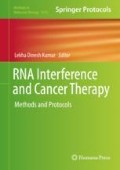Abstract
Gold nanoparticles (GNPs) have emerged as a potential scaffold for a wide range of biomedical applications such as biosensing, drug delivery, and imaging. However, the toxicity of nanoparticles remains a challenge for using them in biological system. The morphology and surface chemistry of GNP can be manipulated by their method of preparation. GNP can be synthesized and functionalized by various methods. This chapter illustrates the synthesis of highly biocompatible GNP using a natural gum, i.e., xanthan gum (XG). Moreover, due to the presence of mannose moiety in XG, these XG-stabilized GNP may also act as self-targeted drug carriers for the delivery of chemotherapeutic agents/siRNA/shRNA to mannose receptor overexpressing cancer cells.
Access this chapter
Tax calculation will be finalised at checkout
Purchases are for personal use only
References
Almeida JP, Figueroa ER, Drezek RA (2014) Gold nanoparticle mediated cancer immunotherapy. Nanomedicine 10(3):503–514
Pissuwan D, Niidome T, Cortie MB (2011) The forthcoming applications of gold nanoparticles in drug and gene delivery systems. J Control Release 149(1):65–71
Oliveira R, Zhao P, Li N et al (2013) Synthesis and in vitro studies of gold nanoparticles loaded with docetaxel. Adv Colloid Interf Sci 199(200):44–58
Chen YH, Tsai CY, Huang PY et al (2007) Methotrexate conjugated to gold nanoparticles inhibits tumor growth in a syngeneic lung tumor model. Mol Pharm 4(5):713–722
Gibson JD, Khanal BP, Zubarev ER (2007) Paclitaxel-functionalized gold nanoparticles. J Am Chem Soc 129(37):11653–11661
Aryal S, Grailer JJ, Pilla S et al (2009) Doxorubicin conjugated gold nanoparticles as water-soluble and pH-responsive anticancer drug nanocarriers. J Mater Chem 19:7879–7884
Prabaharan M, Grailer JJ, Pilla S et al (2009) Gold nanoparticles with a monolayer of doxorubicin-conjugated amphiphilic block copolymer for tumor-targeted drug delivery. Biomaterials 30(30):6065–6075
Burygin GL, Khlebtsov BN, Shantrokha AN et al (2009) On the enhanced antibacterial activity of antibiotics mixed with gold nanoparticles. Nanoscale Res Lett 4(8):794–801
Duncan B, Kim C, Rotello VM (2010) Gold nanoparticle platforms as drug and biomacromolecule delivery systems. J Control Release 148:122–127
Jung J, Park S, Hong S et al (2014) Synthesis of gold nanoparticles with glycosides: synthetic trends based on the structures of glycones and aglycones. Carbohydr Res 386:57–61
Khan MS, Vishakantea D, Siddaramaiah H (2013) Gold nanoparticles: a paradigm shift in biomedical applications. Adv Colloid Interf Sci 199–200:44–58
Saha B, Bhattacharya J, Mukherjee A et al (2007) In vitro structural and functional evaluation of gold nanoparticles conjugated antibiotics. Nanoscale Res Lett 2(12):614–622
Mirza AZ, Shamshad H (2011) Preparation and characterization of doxorubicin functionalized gold nanoparticles. Eur J Med Chem 46(5):1857–1860
Rouhana LL, Jaber JA, Schlenoff JB (2007) Aggregation-resistant water-soluble gold nanoparticles. Langmuir 23:12799–12801
Dhar S, Reddy EM, Shiras A et al (2008) Natural gum reduced/stabilized gold nanoparticles for drug delivery formulations. Chem Eur J 14(33):10244–10250
Tiraferri A, Chen KL, Sethi R et al (2008) Reduced aggregation and sedimentation of zero-valent iron nanoparticles in the presence of guar gum. J Colloid Interface Sci 324(1–2):71–79
Comba S, Sethi R (2009) Stabilization of highly concentrated suspensions of iron nanoparticles using shear-thinning gels of xanthan gum. Water Res 43(15):3717–3726
Xue D, Sethi R (2012) Viscoelastic gels of guar and xanthan gum mixtures provide long-term stabilization of iron micro- and nanoparticles. J Nanopart Res 14:1239–1253
Jian H, Zhu L, Zhang W et al (2012) Galactomannan (from Gleditsia sinensis Lam.) and xanthan gum matrix tablets for controlled delivery of theophylline: in vitro drug release and swelling behaviour. Carbohydr Polym 87:2176–2182
Sereno NM, Hill SE, Mitchell JR (2007) Impact of the extrusion process on xanthan gum behaviour. Carbohydr Res 342(10):1333–1342
Sharma BR, Naresh L, Dhuldhoya NC et al (2006) Xanthan gum—a boon to food industry. Food promotion chronicle 1(5):27–30
Phaechamud T, Ritthidej GC (2007) Sustained-release from layered matrix system comprising chitosan and xanthan gum. Drug Dev Ind Pharm 33:595–605
Santos H, Veiga F, Pina ME et al (2005) Compaction compression and drug release properties of diclofenac sodium and ibuprofen pellets comprising xanthan gum as a sustained release agent. Int J Pharm 295(1–2):15–27
Sinha VR, Mittal BR, Bhutani KK et al (2004) Colonic drug delivery of 5-fluorouracil: an in vitro evaluation. Int J Pharm 269(1):101–108
Desplanques S, Renou F, Grisel M et al (2012) Impact of chemical composition of xanthan and acacia gums on the emulsification and stability of oil-in-water emulsions. Food Hydrocoll 27:401–410
Fan G, Cang L, Qin W et al (2013) Surfactants-enhanced electrokinetic transport of xanthan gum stabilized nanoPd/Fe for the remediation of PCBs contaminated soils. Sep Purif Technol 114:64–72
Comba S, Dalmazzo D, Santagata E et al (2011) Rheological characterization of xanthan suspensions of nanoscale iron for injection in porous media. J Hazard Mater 185(2–3):598–605
Vecchia ED, Luna M, Sethi R (2009) Transport in porous media of highly concentrated iron micro- and nanoparticles in the presence of xanthan gum. Environ Sci Technol 43(23):8942–8947
Carvalho C, Santos RX, Cardoso S et al (2009) Doxorubicin: the good, the bad and the ugly effect. Curr Med Chem 16(25):3267–3285
Laginha KM, Verwoert S, Charrois GJR et al (2005) Determination of doxorubicin levels in whole tumor and tumor nuclei in murine breast cancer tumors. Clin Cancer Res 11:6944–6949
Gu YJ, Cheng J, Man CW et al (2012) Gold-doxorubicin nanoconjugates for overcoming multidrug resistance. Nanomedicine 8(2):204–211
Acknowledgments
The work described in this book chapter has been published as Deep Pooja et al., Xanthan gum stabilized gold nanoparticles: Characterization, biocompatibility, stability and cytotoxicity. Carbohydrate Polymers 2014;110:1–9. The work is reused after permission from Elsevier under license number 4236430677285.
Author information
Authors and Affiliations
Editor information
Editors and Affiliations
Rights and permissions
Copyright information
© 2019 Springer Science+Business Media, LLC, part of Springer Nature
About this protocol
Cite this protocol
Pooja, D., Sistla, R. (2019). Design of Eco-Friendly Gold Nanoparticles for Cancer Treatment. In: Dinesh Kumar, L. (eds) RNA Interference and Cancer Therapy. Methods in Molecular Biology, vol 1974. Humana, New York, NY. https://doi.org/10.1007/978-1-4939-9220-1_16
Download citation
DOI: https://doi.org/10.1007/978-1-4939-9220-1_16
Published:
Publisher Name: Humana, New York, NY
Print ISBN: 978-1-4939-9219-5
Online ISBN: 978-1-4939-9220-1
eBook Packages: Springer Protocols

